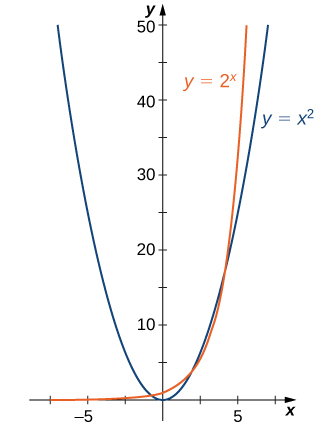
and
In this section we examine exponential and logarithmic functions. We use the properties of these functions to solve equations involving exponential or logarithmic terms, and we study the meaning and importance of the number
We also define hyperbolic and inverse hyperbolic functions, which involve combinations of exponential and logarithmic functions. (Note that we present alternative definitions of exponential and logarithmic functions in the chapter Applications of Integrations, and prove that the functions have the same properties with either definition.)
Exponential functions arise in many applications. One common example is population growth.
For example, if a population starts with
individuals and then grows at an annual rate of
its population after 1 year is
Its population after 2 years is
In general, its population after
years is
which is an exponential function. More generally, any function of the form
where
is an exponential function with base
and exponent x. Exponential functions have constant bases and variable exponents. Note that a function of the form
for some constant
is not an exponential function but a power function.
To see the difference between an exponential function and a power function, we compare the functions
and
In [link], we see that both
and
approach infinity as
Eventually, however,
becomes larger than
and grows more rapidly as
In the opposite direction, as
whereas
The line
is a horizontal asymptote for
In [link], we graph both
and
to show how the graphs differ.

Recall the properties of exponents: If
is a positive integer, then we define
(with
factors of
If
is a negative integer, then
for some positive integer
and we define
Also,
is defined to be
If
is a rational number, then
where
and
are integers and
For example,
However, how is
defined if
is an irrational number? For example, what do we mean by
This is too complex a question for us to answer fully right now; however, we can make an approximation. In [link], we list some rational numbers approaching
and the values of
for each rational number
are presented as well. We claim that if we choose rational numbers
getting closer and closer to
the values of
get closer and closer to some number
We define that number
to be
Suppose a particular population of bacteria is known to double in size every
hours. If a culture starts with
bacteria, the number of bacteria after
hours is
The number of bacteria after
hours is
In general, the number of bacteria after
hours is
Letting
we see that the number of bacteria after
hours is
Find the number of bacteria after
hours,
hours, and
hours.
The number of bacteria after 6 hours is given by
bacteria. The number of bacteria after
hours is given by
bacteria. The number of bacteria after
hours is given by
bacteria.
Given the exponential function
evaluate
and
Go to World Population Balance for another example of exponential population growth.
For any base
the exponential function
is defined for all real numbers
and
Therefore, the domain of
is
and the range is
To graph
we note that for
is increasing on
and
as
whereas
as
On the other hand, if
is decreasing on
and
as
whereas
as
([link]).
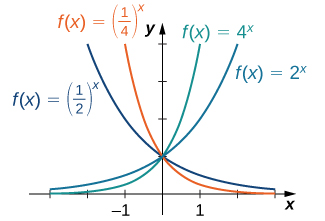
Visit this site for more exploration of the graphs of exponential functions.
Note that exponential functions satisfy the general laws of exponents. To remind you of these laws, we state them as rules.
For any constants
and for all x and y,
Use the laws of exponents to simplify each of the following expressions.
Use the laws of exponents to simplify
A special type of exponential function appears frequently in real-world applications. To describe it, consider the following example of exponential growth, which arises from compounding interest in a savings account. Suppose a person invests
dollars in a savings account with an annual interest rate
compounded annually. The amount of money after 1 year is
The amount of money after
years is
More generally, the amount after
years is
If the money is compounded 2 times per year, the amount of money after half a year is
The amount of money after
year is
After
years, the amount of money in the account is
More generally, if the money is compounded
times per year, the amount of money in the account after
years is given by the function
What happens as
To answer this question, we let
and write
and examine the behavior of
as
using a table of values ([link]).
Looking at this table, it appears that
is approaching a number between
and
as
In fact,
does approach some number as
We call this **number
**{: data-type=”term”}. To six decimal places of accuracy,
The letter
was first used to represent this number by the Swiss mathematician Leonhard Euler during the 1720s. Although Euler did not discover the number, he showed many important connections between
and logarithmic functions. We still use the notation
today to honor Euler’s work because it appears in many areas of mathematics and because we can use it in many practical applications.
Returning to our savings account example, we can conclude that if a person puts
dollars in an account at an annual interest rate
compounded continuously, then
This function may be familiar. Since functions involving base
arise often in applications, we call the function
the natural exponential function. Not only is this function interesting because of the definition of the number
but also, as discussed next, its graph has an important property.
Since
we know
is increasing on
In [link], we show a graph of
along with a tangent line to the graph of at
We give a precise definition of tangent line in the next chapter; but, informally, we say a tangent line to a graph of
at
is a line that passes through the point
and has the same “slope” as
at that point
The function
is the only exponential function
with tangent line at
that has a slope of 1. As we see later in the text, having this property makes the natural exponential function the most simple exponential function to use in many instances.
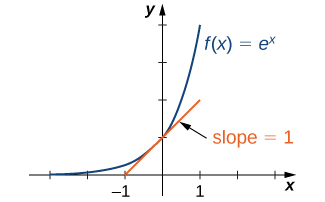
Suppose
is invested in an account at an annual interest rate of
compounded continuously.
denote the number of years after the initial investment and
denote the amount of money in the account at time
Find a formula for
years and after
years.
dollars are invested in an account at an annual interest rate
compounded continuously, then
Here
and
Therefore,
years, the amount of money in the account is
After
years, the amount of money in the account is
If
is invested in an account at an annual interest rate of
compounded continuously, find a formula for the amount of money in the account after
years. Find the amount of money after
years.
After
years, there will be approximately
Using our understanding of exponential functions, we can discuss their inverses, which are the logarithmic functions. These come in handy when we need to consider any phenomenon that varies over a wide range of values, such as pH in chemistry or decibels in sound levels.
The exponential function
is one-to-one, with domain
and range
Therefore, it has an inverse function, called the logarithmic function with base
For any
the logarithmic function with base b, denoted
has domain
and range
and satisfies
For example,
Furthermore, since
and
are inverse functions,
The most commonly used logarithmic function is the function
Since this function uses natural
as its base, it is called the natural logarithm. Here we use the notation
or
to mean
For example,
Since the functions
and
are inverses of each other,
and their graphs are symmetric about the line
([link]).
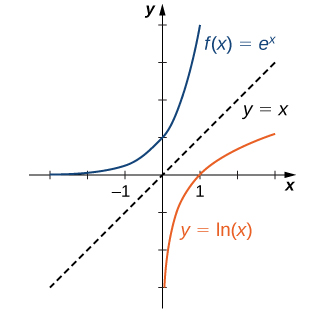
At this site you can see an example of a base-10 logarithmic scale.
In general, for any base
the function
is symmetric about the line
with the function
Using this fact and the graphs of the exponential functions, we graph functions
for several values of
([link]).
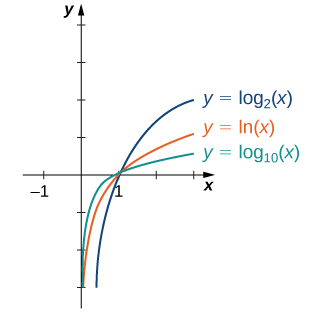
Before solving some equations involving exponential and logarithmic functions, let’s review the basic properties of logarithms.
If
and
is any real number, then
Solve each of the following equations for
Using the power property of logarithms,
Therefore,
we arrive at the equation
Rewriting this equation as
we can then rewrite it as a quadratic equation in
Now we can solve the quadratic equation. Factoring this equation, we obtain
Therefore, the solutions satisfy
and
Taking the natural logarithm of both sides gives us the solutions
Solve
First solve the equation for
Solve each of the following equations for
Therefore, the solution is
Therefore, the equation can be rewritten as
The solution is
Using the quotient property, this becomes
Therefore,
which implies
We should then check for any extraneous solutions.
Solve
First use the power property, then use the product property of logarithms.
When evaluating a logarithmic function with a calculator, you may have noticed that the only options are
or log, called the common logarithm, or ln, which is the natural logarithm. However, exponential functions and logarithm functions can be expressed in terms of any desired base
If you need to use a calculator to evaluate an expression with a different base, you can apply the change-of-base formulas first. Using this change of base, we typically write a given exponential or logarithmic function in terms of the natural exponential and natural logarithmic functions.
Let
and
for any real number
If
this equation reduces to
for any real number
If
this equation reduces to
For the first change-of-base formula, we begin by making use of the power property of logarithmic functions. We know that for any base
Therefore,
In addition, we know that
and
are inverse functions. Therefore,
Combining these last two equalities, we conclude that
To prove the second property, we show that
Let
and
We will show that
By the definition of logarithmic functions, we know that
and
From the previous equations, we see that
Therefore,
Since exponential functions are one-to-one, we can conclude that
□
Use a calculating utility to evaluate
with the change-of-base formula presented earlier.
Use the second equation with
and
Use the change-of-base formula and a calculating utility to evaluate
Use the change of base to rewrite this expression in terms of expressions involving the natural logarithm function.

In 1935, Charles Richter developed a scale (now known as the Richter scale) to measure the magnitude of an earthquake. The scale is a base-10 logarithmic scale, and it can be described as follows: Consider one earthquake with magnitude
on the Richter scale and a second earthquake with magnitude
on the Richter scale. Suppose
which means the earthquake of magnitude
is stronger, but how much stronger is it than the other earthquake? A way of measuring the intensity of an earthquake is by using a seismograph to measure the amplitude of the earthquake waves. If
is the amplitude measured for the first earthquake and
is the amplitude measured for the second earthquake, then the amplitudes and magnitudes of the two earthquakes satisfy the following equation:
Consider an earthquake that measures 8 on the Richter scale and an earthquake that measures 7 on the Richter scale. Then,
Therefore,
which implies
or
Since
is 10 times the size of
we say that the first earthquake is 10 times as intense as the second earthquake. On the other hand, if one earthquake measures 8 on the Richter scale and another measures 6, then the relative intensity of the two earthquakes satisfies the equation
Therefore,
That is, the first earthquake is 100 times more intense than the second earthquake.
How can we use logarithmic functions to compare the relative severity of the magnitude 9 earthquake in Japan in 2011 with the magnitude 7.3 earthquake in Haiti in 2010?
To compare the Japan and Haiti earthquakes, we can use an equation presented earlier:
Therefore,
and we conclude that the earthquake in Japan was approximately
times more intense than the earthquake in Haiti.
Compare the relative severity of a magnitude
earthquake with a magnitude
earthquake.
The magnitude
earthquake is roughly
times as severe as the magnitude
earthquake.
The hyperbolic functions are defined in terms of certain combinations of
and
These functions arise naturally in various engineering and physics applications, including the study of water waves and vibrations of elastic membranes. Another common use for a hyperbolic function is the representation of a hanging chain or cable, also known as a catenary ([link]). If we introduce a coordinate system so that the low point of the chain lies along the
-axis, we can describe the height of the chain in terms of a hyperbolic function. First, we define the hyperbolic functions.

Hyperbolic cosine
Hyperbolic sine
Hyperbolic tangent
Hyperbolic cosecant
Hyperbolic secant
Hyperbolic cotangent
The name cosh rhymes with “gosh,” whereas the name sinh is pronounced “cinch.” Tanh, sech, csch, and coth are pronounced “tanch,” “seech,” “coseech,” and “cotanch,” respectively.
Using the definition of
and principles of physics, it can be shown that the height of a hanging chain, such as the one in [link], can be described by the function
for certain constants
and
But why are these functions called hyperbolic functions? To answer this question, consider the quantity
Using the definition of
and
we see that
This identity is the analog of the trigonometric identity
Here, given a value
the point
lies on the unit hyperbola
([link]).
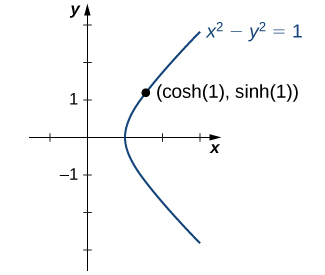
To graph
and
we make use of the fact that both functions approach
as
since
as
As
approaches
whereas
approaches
Therefore, using the graphs of
and
as guides, we graph
and
To graph
we use the fact that
for all
as
and
as
The graphs of the other three hyperbolic functions can be sketched using the graphs of
and
([link]).
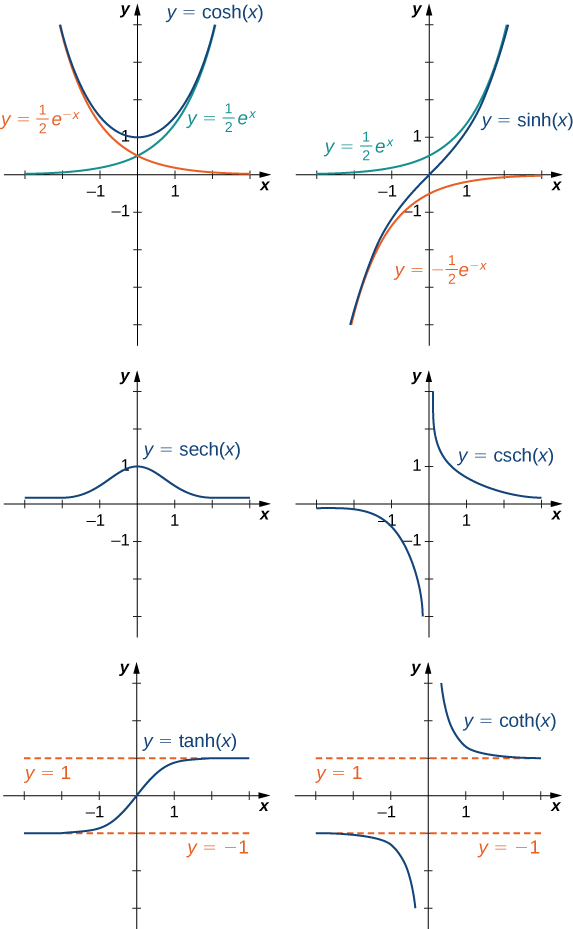
The identity
shown in [link], is one of several identities involving the hyperbolic functions, some of which are listed next. The first four properties follow easily from the definitions of hyperbolic sine and hyperbolic cosine. Except for some differences in signs, most of these properties are analogous to identities for trigonometric functions.
find the values of the remaining five hyperbolic functions.
function, we write
we see that
Since
for all
we must have
Then, using the definitions for the other hyperbolic functions, we conclude that
and
Simplify
Use the definition of the cosh function and the power property of logarithm functions.
From the graphs of the hyperbolic functions, we see that all of them are one-to-one except
and
If we restrict the domains of these two functions to the interval
then all the hyperbolic functions are one-to-one, and we can define the inverse hyperbolic functions. Since the hyperbolic functions themselves involve exponential functions, the inverse hyperbolic functions involve logarithmic functions.
Inverse Hyperbolic Functions
Let’s look at how to derive the first equation. The others follow similarly. Suppose
Then,
and, by the definition of the hyperbolic sine function,
Therefore,
Multiplying this equation by
we obtain
This can be solved like a quadratic equation, with the solution
Since
the only solution is the one with the positive sign. Applying the natural logarithm to both sides of the equation, we conclude that
Evaluate each of the following expressions.
Evaluate
Use the definition of
and simplify.
is increasing if
and decreasing if
Its domain is
and its range is
is the inverse of
Its domain is
and its range is
and the natural logarithmic function is
we can make a change of base to convert this function to any base
We typically convert to base
and
As a result, the inverse hyperbolic functions involve the natural logarithm.
For the following exercises, evaluate the given exponential functions as indicated, accurate to two significant digits after the decimal.
a.
b.
c.
a. 125 b. 2.24 c. 9.74
a.
b.
c.
a.
b.
c.
a. 0.01 b. 10,000 c. 46.42
a.
b.
c.
For the following exercises, match the exponential equation to the correct graph.
d
b
e
For the following exercises, sketch the graph of the exponential function. Determine the domain, range, and horizontal asymptote.
Domain: all real numbers, range:
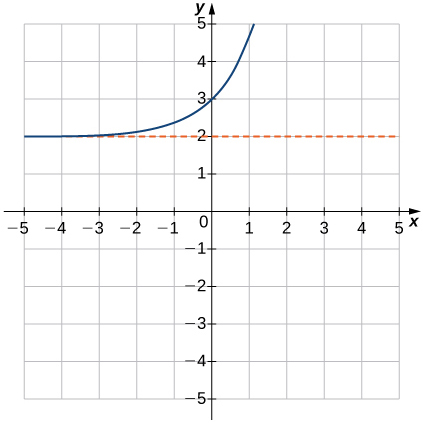
Domain: all real numbers, range:
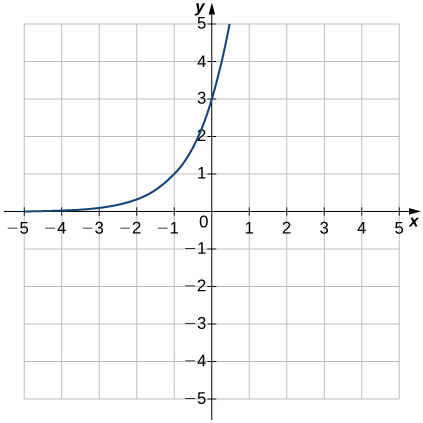
Domain: all real numbers, range:
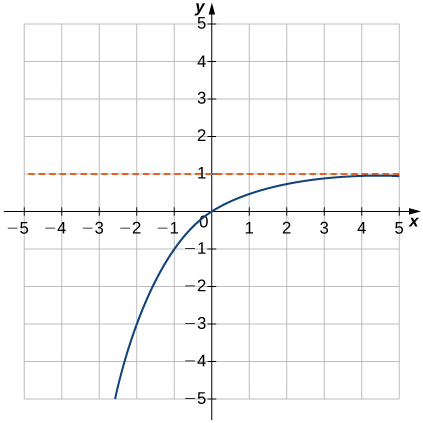
Domain: all real numbers, range:

For the following exercises, write the equation in equivalent exponential form.
For the following exercises, write the equation in equivalent logarithmic form.
For the following exercises, sketch the graph of the logarithmic function. Determine the domain, range, and vertical asymptote.
Domain:
range:
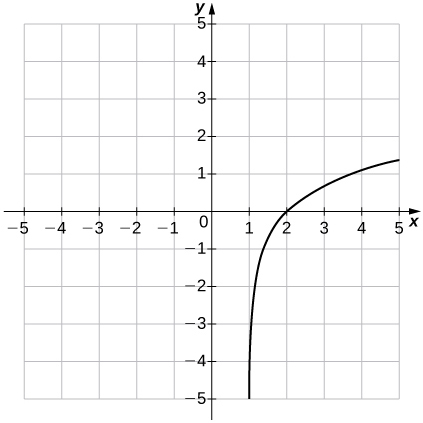
Domain:
range:
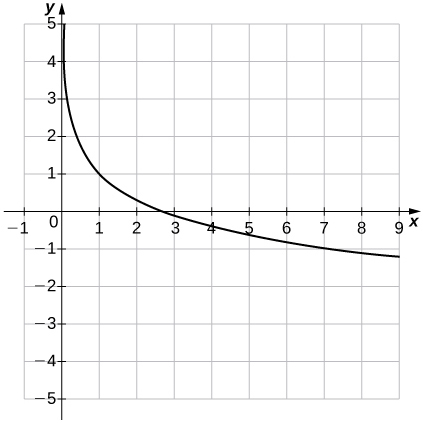
Domain:
range:
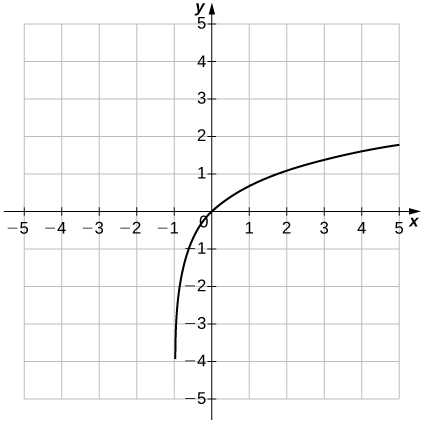
For the following exercises, use properties of logarithms to write the expressions as a sum, difference, and/or product of logarithms.
For the following exercises, solve the exponential equation exactly.
For the following exercises, solve the logarithmic equation exactly, if possible.
For the following exercises, use the change-of-base formula and either base 10 or base e to evaluate the given expressions. Answer in exact form and in approximate form, rounding to four decimal places.
Rewrite the following expressions in terms of exponentials and simplify.
a.
b.
c.
d.
[T] The number of bacteria N in a culture after t days can be modeled by the function
Find the number of bacteria present after 15 days.
[T] The demand D (in millions of barrels) for oil in an oil-rich country is given by the function
where p is the price (in dollars) of a barrel of oil. Find the amount of oil demanded (to the nearest million barrels) when the price is between $15 and $20.
[T] The amount A of a $100,000 investment paying continuously and compounded for t years is given by
Find the amount A accumulated in 5 years.
Approximately $131,653 is accumulated in 5 years.
[T] An investment is compounded monthly, quarterly, or yearly and is given by the function
where
is the value of the investment at time
is the initial principle that was invested,
is the annual interest rate, and
is the number of time the interest is compounded per year. Given a yearly interest rate of 3.5% and an initial principle of $100,000, find the amount
accumulated in 5 years for interest that is compounded a. daily, b., monthly, c. quarterly, and d. yearly.
[T] The concentration of hydrogen ions in a substance is denoted by
measured in moles per liter. The pH of a substance is defined by the logarithmic function
This function is used to measure the acidity of a substance. The pH of water is 7. A substance with a pH less than 7 is an acid, whereas one that has a pH of more than 7 is a base.
mol/L
mol/L
mol/L
i. a. pH = 8 b. Base ii. a. pH = 3 b. Acid iii. a. pH = 4 b. Acid
[T] Iodine-131 is a radioactive substance that decays according to the function
where
is the initial quantity of a sample of the substance and t is in days. Determine how long it takes (to the nearest day) for 95% of a quantity to decay.
[T] According to the World Bank, at the end of 2013 (
) the U.S. population was 316 million and was increasing according to the following model:
where P is measured in millions of people and t is measured in years after 2013.
a.
million b. 94 years from 2013, or in 2107
[T] The amount A accumulated after 1000 dollars is invested for t years at an interest rate of 4% is modeled by the function
[T] A bacterial colony grown in a lab is known to double in number in 12 hours. Suppose, initially, there are 1000 bacteria present.
to determine the value
which is the growth rate of the bacteria. Round to four decimal places.
a.
b.
hours
[T] The rabbit population on a game reserve doubles every 6 months. Suppose there were 120 rabbits initially.
to determine the growth rate constant
Round to four decimal places.
[T] The 1906 earthquake in San Francisco had a magnitude of 8.3 on the Richter scale. At the same time, in Japan, an earthquake with magnitude 4.9 caused only minor damage. Approximately how much more energy was released by the San Francisco earthquake than by the Japanese earthquake?
The San Francisco earthquake had
times more energy than the Japan earthquake.
True or False? Justify your answer with a proof or a counterexample.
A function is always one-to-one.
assuming f and g are functions.
False
A relation that passes the horizontal and vertical line tests is a one-to-one function.
A relation passing the horizontal line test is a function.
False
For the following problems, state the domain and range of the given functions:
h
g
Domain:
range: all real numbers
Domain:
and
range: all real numbers
Find the degree, y-intercept, and zeros for the following polynomial functions.
Degree of 3,
-intercept: 0, zeros: 0,
Simplify the following trigonometric expressions.
or
Solve the following trigonometric equations on the interval
exactly.
Solve the following logarithmic equations.
4
Are the following functions one-to-one over their domain of existence? Does the function have an inverse? If so, find the inverse
of the function. Justify your answer.
One-to-one; yes, the function has an inverse; inverse:
For the following problems, determine the largest domain on which the function is one-to-one and find the inverse on that domain.
A car is racing along a circular track with diameter of 1 mi. A trainer standing in the center of the circle marks his progress every 5 sec. After 5 sec, the trainer has to turn 55° to keep up with the car. How fast is the car traveling?
For the following problems, consider a restaurant owner who wants to sell T-shirts advertising his brand. He recalls that there is a fixed cost and variable cost, although he does not remember the values. He does know that the T-shirt printing company charges $440 for 20 shirts and $1000 for 100 shirts.
a. Find the equation
that describes the total cost as a function of number of shirts and b. determine how many shirts he must sell to break even if he sells the shirts for $10 each.
a.
b. 100 shirts
a. Find the inverse function
and describe the meaning of this function. b. Determine how many shirts the owner can buy if he has $8000 to spend.
For the following problems, consider the population of Ocean City, New Jersey, which is cyclical by season.
The population can be modeled by
where
is time in months
represents January 1) and
is population (in thousands). During a year, in what intervals is the population less than 20,000? During what intervals is the population more than 140,000?
The population is less than 20,000 from December 8 through January 23 and more than 140,000 from May 29 through August 2
In reality, the overall population is most likely increasing or decreasing throughout each year. Let’s reformulate the model as
where
is time in months (
represents January 1) and
is population (in thousands). When is the first time the population reaches 200,000?
For the following problems, consider radioactive dating. A human skeleton is found in an archeological dig. Carbon dating is implemented to determine how old the skeleton is by using the equation
where
is the percentage of radiocarbon still present in the material,
is the number of years passed, and
is the decay rate of radiocarbon.
If the skeleton is expected to be 2000 years old, what percentage of radiocarbon should be present?
78.51%
Find the inverse of the carbon-dating equation. What does it mean? If there is 25% radiocarbon, how old is the skeleton?
in the exponential function
and the logarithmic function
in the expression
and
which involve certain combinations of
and
and
are restricted to the domain
each of these functions can be expressed in terms of a composition of the natural logarithm function and an algebraic function
gets larger, the quantity
gets closer to some real number; we define that real number to be
the value of
is approximately

You can also download for free at http://cnx.org/contents/9a1df55a-b167-4736-b5ad-15d996704270@5.1
Attribution: